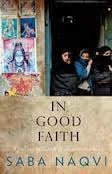Book Review: In Good Faith by Saba Naqvi, Rainlight-Rupa, 191 pp; Rs 395(Hardback) A long stretch of history has been driven by the complexities of religion, seldom it allows anything more normal than keeping practitioners, either sycophant or intolerant under its extreme persuasion. But beyond that maliciously institutionalized trajectory, there is still a way open for the believers, who are not steadfast and have better consine to adjust with the historical realities. In dwelling with those uneven realities of India, mere relying on the western notion of ‘syncretism’ would not be adequate, as the long walk of colonisation and shaping of religions on this land happened much unusually than the rest of the world.
Saba Naqvi’s In Good Faith basically deals with those fogged issues, mostly taken for identity politics and hatred than as tools for revisiting the deepness of identity itself. Unlike the academic researches, Saba’s journey as a political journalist is indeed to search for “an unknown India”, which is a living reality even in adverse shades. The book is splitted in chapters and each part deals with the peculiarities of common religious practices of a community - there is no repetition in exchanges of contents but still the chapters altogether establish the mandate that is broad and remarkable.
Through her beautiful journalistic account, Saba aptly breaks the preoccupied version of religious blockings and advances the case of “common god”, which people and communities have given accord before religion turned into a profitable segment. Her quest is for those forgotten realities, whose effects would have countered the easy flow of fundamentalism in popular politics and social life. In its end result, pluralism missed to go further, as the downside of cynical politics has maintained its virulent character intact, even when Nehru’s ‘tryst with destiny’ speech have crossed its sixty-fifth anniversary this year.
Every Indian has the right to learn about its shrines and monuments, sadly few of us apply our temptation for this. For reckoning the pulse of history (only few historians find it essential, so the disciplinary formalities are of little value) and religion in action, the social and individual interpretation of life and its monuments would be more worthwhile than spending hours reading the dictum of follow-up texts on the scriptures. What even the ‘social history’ project would be unable to attain on spiral of identities could be easily conquered by the journey of simple and sensible travelers.
This book comprises rich detail, “From the Muslim goddess of Bengal to an unknown facet of the Shivaji legend in Maharashtra; from the disputed origins of the Shirdi Sai Baba to shrines across the land that are both temple and dargah”. Here the author sees a tolerant India is still surviving though only on the margins. This book is important as it has so much to offer on the ‘identity debate’. It unravels many myths and follies. In fair probability, religion should not have meant for tussle, but it is in vogue, hence a book like this has much relevance.
Atul K Thakur
Email: summertickets@gmail.com
(Published in Kashmir Reader on December26,2012)
Monday, December 31, 2012
On faith,with reason
Subscribe to:
Post Comments (Atom)





No comments:
Post a Comment